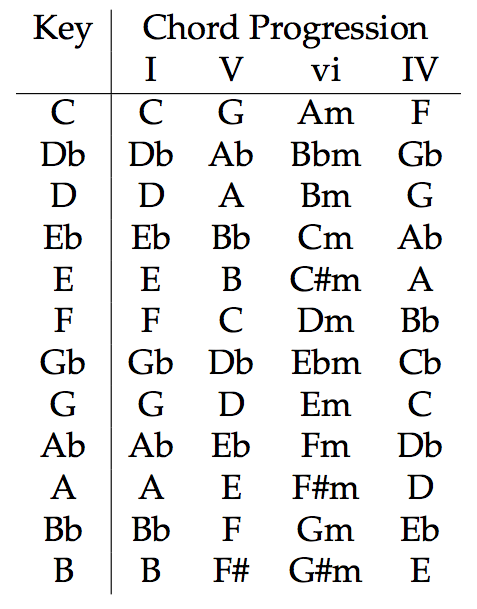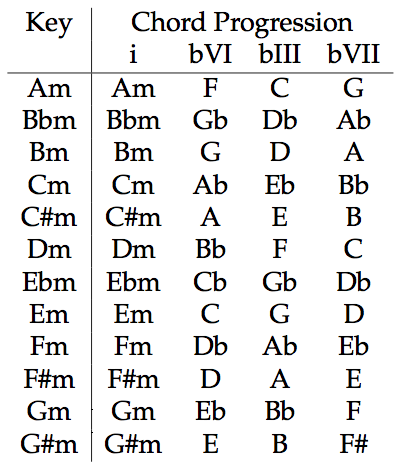The 4-Chords Pop Progression
Today I want to make you guys part of one of the songwriting secrets that professional pop songwriters use to make their songs a smashing hit. What I am about to explain is one of the things that separates pro musicians from the other listeners: just knowing this will change the way that you listen to music. You will start to recognize this trick over and over in many of your favorite songs. It will also help you in writing a song that will sell.
That’s the secret in a nutshell: an incredible number of pop songs all share the SAME chord progression.
The first time somebody told me that, I immediately objected that this could not be the case: two songs with the same chord progression would sound too similar. Well, I discovered later that I was wrong: while the chord progression might be the same, the melody, the lyrics, the rhythm, the arrangement may be different from song to song, and these elements are enough to mask the fact that they have the same chord progression.
The fact is: this chord progression sounds GOOD and the public loves it (even if they are unaware it is the same progression). If you have a look at the end of this lesson, I compiled a short list of songs that use it, either in the verse or in the chorus. I am willing to bet you didn’t realize that all these songs had something so important in common.
Let’s see this infamous chord progression in action.
Major Version
This chord progression exists in two different version: major and minor. In the major version the chord progression is: I V vi IV; that is the first chord of a major key (I), followed by the 5th chord of the key (V), then the 6th (vi), and then the fourth (IV). The roman numerals for chords I, IV, and V are in capital letters to indicate that these chords are major chords, while the chords vi is written in the lower case to indicate that it’s a minor chord. For your convenience I wrote this chord progression in all the major keys:

Minor Version
The pop chord progression in a minor key is written as i bVI bIII bVII. That is, the first chord of the minor key (i), then the 6th chord (bVI), then the 3rd chord (bIII), then the 7th chord (bVII). As before, capital numerals denote major chords while lower case numerals denote minor chords. The numerals for the 3rd, 6th, and 7th chords have a flat sign before them (“b”) to indicate that they are coming from the minor scale (I will explain why is this in a future lesson — for the time being just follow the table below). Here you can find the chord progression in all the minor keys.

Are They the Same Progression?
If you compare the chord progression for C major (C G Am F) and the chord progression for A minor (Am F C G) you will see that they are actually the same progression: they have the same chords in the same order, the only difference being the starting point. In C major we are starting from the C chord, while in Am we are starting from the Am chord. You can see by yourself that this holds true in all keys. Just starting from a different chords changes the feeling of the progression, but this does not change the fact that they are actually the same thing.
Is It Really That Used?
Here is a short, non-exahustive list of internationally famous pop songs that include the chord progressions I just explained. Some of these songs use the progression only in the chorus, others only in the verse, others use it in both verse and chorus (i.e. they just repeat the same progression over and over). All these songs sound completely different one from the other until you recognize that they all use the same chords. More songs are being written with this progression each year by pop songwriters. You should write your own too, it might well be a success!
Major Version:
- Let it Be — Beatles
- No Woman No Cry — Bob Marley
- With or Without You — U2
- Take Me Home Country Roads — John Denver
- Don’t Stop Believing — Journey
- Romeo and Juliet — Dire Straits
- So Lonely — The Police
- Under the Bridge — Red Hot Chili Peppers
- Soul To Squeeze — Red Hot Chili Peppers
- Waltzing Matilda — Banjo Patterson
- Cryin’ — Aerosmith
- Don’t Wanna Miss a Thing — Aerosmith
- Torn — Natalie Imbruglia
- Take on Me — A-Ha
- Forever Young — Alphaville
- Down Under — Man at Work
- You’re Beautiful — James Blunt
- Wherever You Will Go — the Calling
- Can You Feel the Love Tonight — Elton John
- She Will Be Loved — Maroon 5
- Fall At Your Feet — Crowded House
- High — Lighthouse Family
- I’m Yours — Jason Mraz
- Girlfriend — Avril Lavigne
Minor Version:
- Africa — Toto
- Snow (Hey Oh) — Red Hot Chili Peppers
- Other Side — Red Hot Chili Peppers
- It’s My Life —Bon Jovi
- Poison — Alice Cooper
- Zombie — Cranberries
- One of Us — Joan Osbourne
- Frozen — Madonna
- The Power of Goodbye — Madonna
- Nothing Really Matters — Madonna (Yes, 3 songs by Madonna in the same album!)
- Save Tonight — Eagle Eye Cherry
- Complicated — Avril Lavigne
- Born to Make You Happy — Britney Spears
- That Don’t Impress Me Much — Shania Twain
Did you know that there are MANY more "standard" chord progressions that songwriter use beyond the pop progression, and that all of them have a number of variations? (that's how they avoid all these songs to sound the same...) If you want to learn more about Guitar Chord Progressions and how to use them to write songs (in any style, not only Pop) then click on the button below and read the page that will appear:
